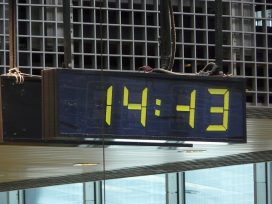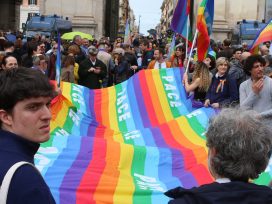The names of the lost
Penal colonies and mysterious deaths of political opponents are still part of Russia’s political machinations today. Remembrance and documentation are criminalized, as the case of Memorial shows. And yet, there is a lot to explore and memorialize – for instance, the thousands of people slaughtered in Sandarmokh forest, Karelia, during Stalin’s Great Terror.
Human rights advocate Kamila Orlova talks to Maksim Lyalin and Anna Tugarinova, co-organizers of the project ‘Sandarmokh: Restoring the Names’.
Kamila Orlova: The post-Soviet Russian state rejects any narrative about the country’s past that contradicts the Kremlin’s rhetoric. Official history valorizes Stalin, aggrandizes Soviet ‘achievements’, and justifies the Great Terror. The Russian state persecutes any attempt to bring real discourse on Stalinist crimes into the public space. On 28 December 2021, the Russian Supreme Court ruled that Memorial International – Russia’s most prominent human rights organization, which holds detailed records on Soviet repressions – should close.
The head of Memorial’s Karelian branch, historian Yuri Dmitriev, was among the first of its activists to be targeted. In 2016, he was arrested on fabricated charges of child pornography after leading research expeditions that discovered several Stalinist camp burial grounds in Karelia’s Sandarmokh forest massif. On 27 December 2021, after a lengthy, politically motivated prosecution supported by fictitious evidence, the Petrozavodsk City Court sentenced Dmitriev to a total of 15 years in a penal colony. Given these extraordinary circumstances, how did the ‘Sandarmokh: Restoring the Names’ project come about?
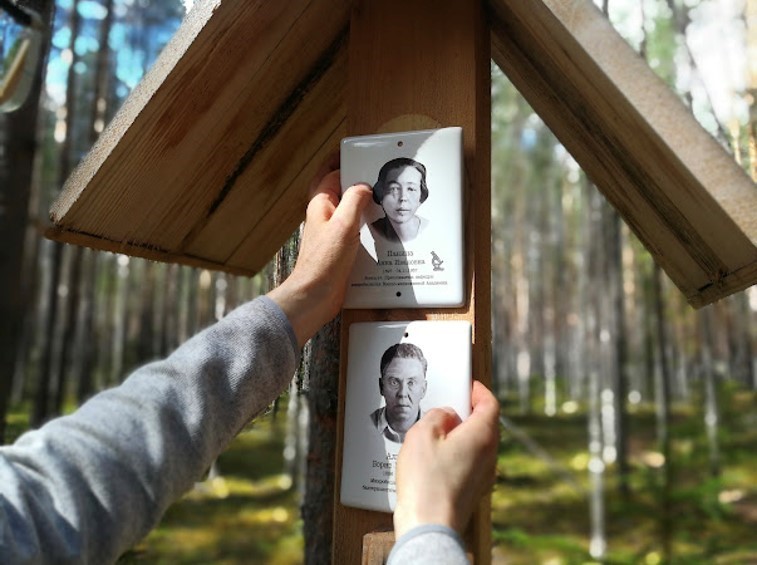
‘Sandarmokh: Restoring the Names’ project, photo courtesy of Amksim Lyalim and Anna Tugarinova
Maksim Lyalin and Anna Tugarinova: Dmitriev published a list of the names of over six thousand people executed in Sandarmokh in 1937-1938, and the project happened mostly thanks to him. ‘Dmitriev’s List’ gave the descendants of those who perished here a unique opportunity to express their need to remember: to bring flowers and light a candle at the site where a family member died. For the most part, their commemoration is not underpinned by any ideology: it is guided solely by love.
In Sandarmokh, remembrance takes a range of different forms: from pencil inscriptions on poles, handmade memorial signs often crafted from paper and hung on trees, to complete gravestones. All this has transformed the former NKVD shooting ground into something akin to a rural graveyard – albeit an abandoned-looking one.
In 2014, Russia crossed the Rubicon: it invaded Ukraine. This was an illegal act, and all the dramatic consequences and social collisions that ensued were bound to affect the Sandarmokh Memorial Cemetery. The participation of state officials at the annual International Remembrance Day for the Victims of Sandarmokh was gradually phased out. In addition, the state’s persistent refusal to refer to the Great Terror as a crime rather than a tragedy, and to Stalin’s henchmen as culprits, has brought with it efforts to present an alternative enemy to the public.
Early in 2016, two historians from Petrozavodsk State University – Yuri Kilin and Sergey Verigin – put forward the view that the remains buried in Sandarmokh were those of Soviet soldiers, imprisoned in Finnish POW camps and executed between 1941 and 1944. On 13 December 2016, Dmitriev, the main figure calling for the government to recognize its responsibility for the past, was arrested on trumped-up charges.
Six months later, in June 2017, Kilin and Verigin’s ‘Finnish Hypothesis’ received broad coverage in the media. The subsequent expedition of the Russian Military Historical Society (RVIO) to Sandarmokh was a logical follow-up. Its purpose was to find the remains of Finnish prisoners and Red Army soldiers. Foregoing any forensic laboratory results, and while the expedition was still in progress, the RVIO presented to the public those they called the ‘real perpetrators’ and ‘actual victims’ killed in the forest. The only thing they could not present was proof.
All these events took place against the backdrop of continuous attacks by the state authorities on the opposition, as well as out-and-out encroachments on the rights of Russian citizens which systematically increased numbers of political prisoners. There were also new arrests, torture in isolation centres and prisons, and abusive convictions.
A combination of historical revisionism, the state’s imposition of an official historical narrative on the public, and the politicization of history, resulted in decreased academic access to historical and political documents held in archives. Meanwhile the human rights group Memorial was added to the list of ‘foreign agents’. The legacy of a historical practice of terror was made evident even to those who had previously denied or ignored it.
In response to this, people turned Sandarmokh into a place commemorating the state’s crimes against humanity. By extension, individual memory served as direct evidence of the crimes that had been committed. Remembrance became an act of individual resistance against attempts by the state — through the RVIO — to rob the Sandarmokh memorial of its meaning and importance in preserving the historical memory of the Great Terror.
It was also an act of protest against the fabricated and politically motivated allegations against Dmitriev. So out of the ten memorial plaques to Belbaltlag and Solovki prisoners which we brought with us, four were made out to people who shared Dmitriev’s last name. In this way, individual memory became an instrument of resistance, a decisive argument presented by citizens in their clash with government about the legacy of political violence perpetrated by the Soviet state.
The first plaques laid the foundation for the public initiative that followed, and this later morphed into the project we know today. Initial memorial ceremonies were conducted as a protest against state attempts to turn Sandarmokh into a combat zone, with the purpose of abrogating responsibility for past crimes and legitimizing a legacy of political terror that continues into the present.
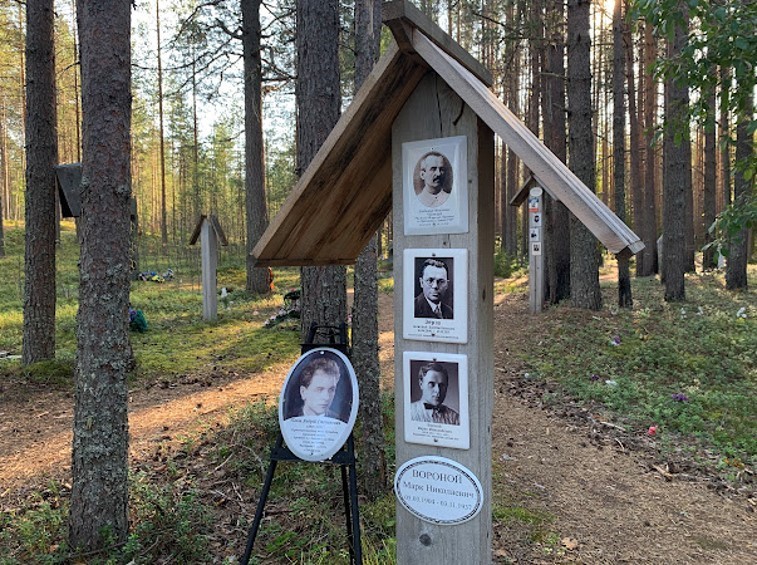
‘Sandarmokh: Restoring the Names’ project, photo courtesy of Amksim Lyalim and Anna Tugarinova
Kamila Orlova: Stalinist NKVD troikas performed executions by firing squad in Sandarmokh, and other shooting grounds, in secret. It was an attempt to ensure that the fact was never discovered. But in 1997, when Dmitriev found the mass graves, all this was unmasked. Ever since, the goal has been to ensure that as many people as possible learn the truth. What channels of communication do you use to connect with existing and potential participants of the initiative?
Maksim Lyalin and Anna Tugarinova: The project is a citizens’ initiative. Its purpose is to preserve the memory of people killed in clandestine mass executions conducted by the NKVD in 1937-1938, in the Belbaltlag camp complex and Baltkombinat (Sandarmokh). Within the framework of this initiative, we recover the story of each individual based on available archival records, search for and restore their photographs, and perpetuate their memory by installing a personal memorial plaque at the place of execution.
The design of each memorial is unique. Its appearance reflects the person’s identity — ethnic, religious and professional. Individual nameplates are generally installed in close proximity to existing ethno-confessional monuments, thereby creating unique spaces of individual remembrance.
Everything is documented and registered on a webpage dedicated to the project. This is our most important tool for communicating with participants, volunteers and subscribers. When publishing the restored biography of any victim of repression on this platform, we invite readers to take part in the production of memorial signs for others executed in these grounds.
Kamila Orlova: Since the disintegration of the Soviet Union, and even to this day, hopes for the rectification of historical injustices have been associated with future generations. Could you talk about the involvement of young people in the initiative?
Maksim Lyalin and Anna Tugarinova: In 2020, we created a link with student volunteers from the Moscow International Film School. Over the past two years, they have helped put up memorial signs for those executed, and compiled videos of ceremonies marking the installations. In summer 2021, we received an offer of collaboration from students of the St Philaret Christian Orthodox Institute, who also contribute to the process of memorial installation and edit videos that tell the stories of murdered prisoners held in the Belbatlag camp complex.
Moreover, in August 2021, we received a further offer of cooperation from students and teachers at the Higher School of Economics in Nizhny Novgorod. Currently, students from the philology faculty are working in archives, studying the case files of prisoners in the Belbaltlag and Solovki special camps, and analyzing their letters. They work with the families and descendants of the repressed, conducting interviews and studying photo archives. We see the participation of young people as key to the Sandarmokh project. As they discover the life stories of prisoners who died here, students learn about the history of the entire country.
Kamila Orlova: Historical memory is under continuous attack in Russia, and the memory of Stalinist repression is itself being repressed. How have participants in the initiative contributed to public discourse on this issue?
Maksim Lyalin and Anna Tugarinova: Three years into this project, we can say with confidence that a new community is beginning to form around Sandarmokh. It is a group of those who remember. People are contributing by covering the cost of producing memorial signs, reconstructing the stories of those who perished in the executions, participating in commemorative ceremonies, and helping to develop the initiative.
Looking at what has been achieved today, it seems clear that a specific section of civil society (people who have assisted or expressed support for the project) has understood and accepted the idea behind it. Letters of support and encouraging comments on the web serve as best proof of this.
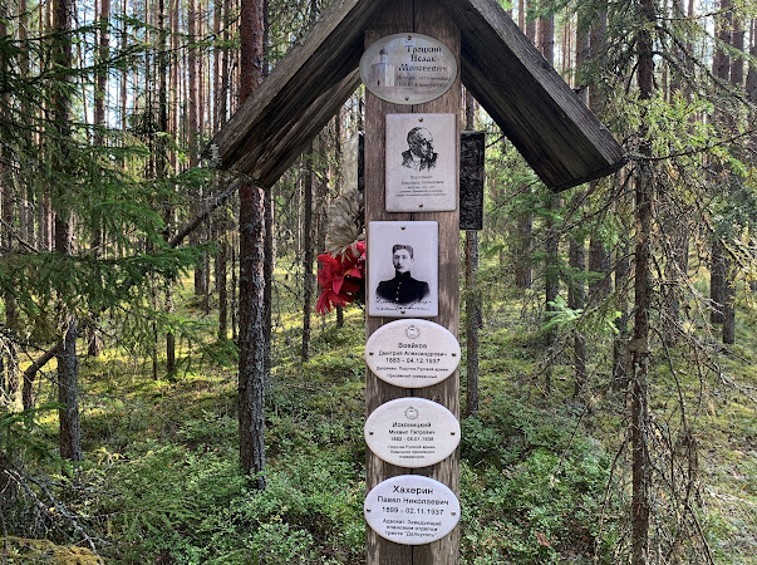
‘Sandarmokh: Restoring the Names’ project, photo courtesy of Amksim Lyalim and Anna Tugarinova
Kamila Orlova: There are many facets to the project. On the one hand you focus on individual memory by restoring the biographies of victims. On the other, this is work which affects collective memory. You are returning the people who were murdered here to the pages of a shared history from which they were once erased. All this, in turn, also perpetuates a long-established debate in Russia about ‘who is to blame?’ and ‘what is to be done?’ What is the most significant aspect of the initiative, as you see it?
Maksim Lyalin and Anna Tugarinova: The project is based on the principle that, united by a common goal, people can become agents of change and transform the memory of Sandarmokh, without appealing to the state for assistance. In August 2021, the project celebrated its third anniversary. Over this time, a civic initiative born from the energy of resistance has become a memorial project in its own right.
Thanks to the participants, 240 memorial plaques have been produced and installed so far. About forty of them have been commissioned by descendants of the repressed. The landscape of work on the memorial cemetery is steadily changing — Sandarmokh is seeing the return of the faces of those who fell victim to the unlawful, extrajudicial killings of 1937-1938.
Today, Sandarmokh is not just a place where people once fell victim to imperial ambition, Soviet state propaganda and the terror of the 1930s. It is a place where the Russia of the living comes face to face with the Russia of the dead. Here contemporary memorialization is indivisible from civic action. It is a place where a conversation between citizens and government is taking place at the scene of the crime. The memorial signs we install provide the evidence of wrongdoing.
As we put up individual commemoration signs, restore the biographies of victims and sign their names into archives, we share publicly the proof of these people’s lives and their deaths. Equally, by extension, we are condemning the culprits. What we aim to achieve is the memorialization of all the people who perished in Sandarmokh. It will then be far harder, in future, for the authorities to substitute these six thousand victims with others they like to call the ‘real’ ones.
The goals of project participants have evolved. Civic resistance, solidarity with political prisoners – and with Sandarmokh as a place of remembrance of the Great Terror – have not disappeared, but to some extent have become secondary. They now represent the ever-present backdrop for future work to sustain the project. Personal memory and individual memorialization no longer play the decisive role in our battle with the establishment to identify the state’s henchmen and the real victims of Sandarmokh.
People still express support for Dmitriev, but now the intention behind their letters appears to be different. Today they write: ‘My older children and I would like to assist in your project and all you do. We wholeheartedly hope that Yuri Dmitriev will soon return to his life’s work’ (from a project participant in the Moscow Region). Another letter from a family in Volgograd says:
What you do is extremely important. You talk about people whom the monstrous repressive machine deprived not only of their lives, but of their names. To this day, someone needs to have these names eliminated from history. But we want to remember. And, within this initiative, we would like the names of four people to be remembered in perpetuity…
Kamila Orlova: Over the past few years, your initiative has probably represented the most significant challenge to the state’s unceasing attempts to rewrite history. You have achieved amazing results over a very short period of time. A lot of hard work has been put in by a great many people. What challenges have you experienced in the process?
Maksim Lyalin and Anna Tugarinova: There have been issues associated with implementing the project. One is a shortage of people. To this day, most of the work is done by just a few committed participants – mostly the organizers themselves. Sadly – with just a few exceptions – local people are not interested in joining the initiative. Most events are organized by volunteers from Moscow and Saint Petersburg, which is alarming if future development and sustainability are considered.
Finally, since 2019, we have been offered help by a number of potential participants whose motives turned out to be less than genuine. They claimed to be committed to our shared goal and expressed a desire to take part in the initiative. In the end, however, their contribution proved to be motivated by personal ambition and a desire for public acclaim: they disseminated false information in the media about the project. This was unhelpful from the point of view of our objectives, but also ended up being damaging and causing us further difficulties.
One lesson we have learned is that there is a real need to identify underlying ulterior motives and ensure that we nip them in the bud.
Published 23 May 2022
Original in English
First published by Eurozine
Contributed by Institute for Human Sciences (IWM) © Maksim Lyalin / Kamila Orlova / Anna Tugarinova / Institute for Human Sciences (IWM) / Eurozine
PDF/PRINTIn collaboration with
In focal points
Newsletter
Subscribe to know what’s worth thinking about.
Related Articles
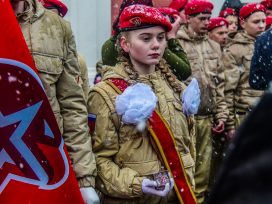
Intellectual violence
The militarization of education in Russia
Education has become another battleground in the Kremlin’s campaign to militarize the Russian public consciousness. Youth organizations, book bans, changes to school curricula – all amount to a ‘special anthropological operation’.

Russian drones entering Polish airspace, militarily seen as intensified provocation rather than open warfare, have nevertheless provoked costly responses – both from NATO’s air defence systems and civilian reactions to disinformation. A war correspondent’s view of what can be done technologically – for greater military efficiency and improved civil defence.

